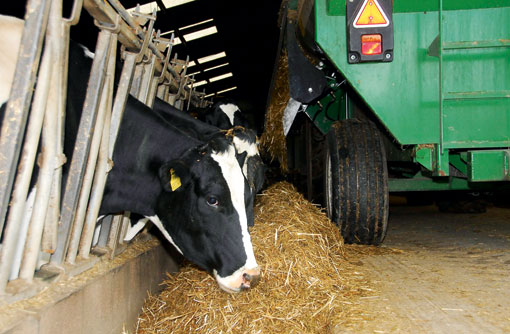Producers warned over straw feed

Dairy producers are placing too much emphasis on feeding straw to dry cows, depressing yields and fertility, according to one consultant. Olivia Cooper reports.
Some producers are feeding too much straw during the dry period at incorrect chop lengths, leading to reduced yield in early lactation, lower peaks and suppressed fertility, according to Kingshay associate, Robert Cope.
Straw is a popular addition to dry cow diets as a preferred way of limiting energy intakes and providing structural fibre, but Mr Cope believes the emphasis on feeding straw during this period is over the top.
“Feeding straw can work, but it needs to be managed really carefully. Often, people don’t chop the straw short enough, and don’t balance the ration correctly. Instead of feeding 4-5kg of straw, they should cut it down to 1kg, and they will see better peaks, fertility and milk yield.”
When feeding straw, it must be included in a mixed ration, chopped to about 2-2.5 inches. “Most people chop it too long, so the cows sort it and leave it, which reduces valuable eating time.”
When far off dry cows are moved off a high-energy silage ration onto a straw diet, they take two to three weeks to adjust to the change, says Mr Cope. “They are moving from a lush, fresh diet to cardboard. That reduces their feed intake and they have no time to recover before calving. Too much straw in the ration also makes it very dry, and reduces the level of digestible protein. That means the rumen doesn’t work as well, so the cows eat less – it is a downward spiral.”
Then, after calving, the cows are shifted back onto maize, silage and concentrates; another massive change. “I think we need to do more metabolic profiling before and after calving – you don’t see the energy imbalance until much later on. If you’re going to feed straw, feed it all the way through drying off to calving, but make sure it’s chopped and mixed correctly.”
Straw does have other benefits though – it reduces dietary potassium and the cation-anion difference, which helps prevent milk fever. In addition, better rumen fill reduces the incidence of digestive disorders, including displaced abomasums. “If you feed normal grass silage it is too high in potassium; instead, pick special dry cow fields and limit fertiliser and slurry applications, to make a special, low-potassium silage for them,” says Mr Cope.
“It should be about 10ME and 13% protein, and leave it to go a bit stemmy to provide decent fibre. If your forage isn’t fibrous enough, add some chopped straw, but don’t just throw it in for the sake of it.”
About three to four weeks before calving, producers should move cows in their peer groups and switch to a feed more closely resembling the milking ration, he adds. “Keep them on the low-potassium silage and increase protein levels to 14%. In my experience, farmers who change from a high-straw diet to a maximum of 1kg of straw in a well-balanced ration find cows eat more post-calving and peak well. They have fewer energy problems, so fertility is improved, and overall yields are higher.”
Case study: Darren and Stuart McMurren, Banbridge, County Down
Darren McMurren, who farms with his brother Stuart at Banbridge, Co.Down, cut the amount of straw in his dry cow ration from 4kg to 1kg last year, with great results.
“We were a bit sceptical about whether it was going to work, but it has. Before, we were having to buy in straw at £120/t to feed the cows. We thought the chop length was okay, but the cows were still sorting it and we couldn’t get them to eat it.”
Following last year’s success, he is now cutting straw out of the ration altogether, and has identified low-potash fields to make silage specifically for the dry cows. “We haven’t had any problems with milk fever – we do temperature check the transition cows to monitor any problems.”
First-served conception rates have increased from 33% to 37%. “It was dreadful – I think the cows just weren’t in good enough condition because they weren’t eating enough.” And yields have also increased, from 8,900 litres a cow a year to 9,600 litres. “It’s a very simple change to make. As a result we’re making a big saving on the straw and getting considerable benefits in yield and fertility.”
